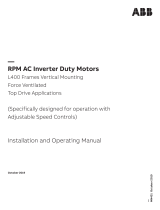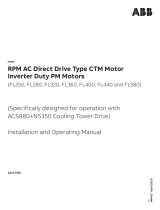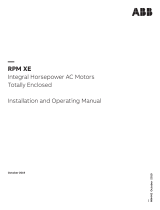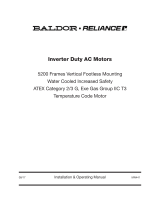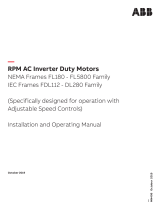5.4 Bearing currents
Insulated bearings or bearing constructions, common
mode filters and suitable cabling and grounding methods
must be used according to the following instructions:
5.4.1 Elimination of bearing currents with
ABB ACS800 and ACS550 converters
In the case of the ABB ACS800 and ACS550-series
frequency converter with a diode supply unit, the following
methods must be used to avoid harmful bearing currents in
the motors:
Nominal Power (Pn)
and / or Frame size (IEC)
Preventive measures
Pn < 100 kW No actions needed
Pn ≥ 100 kW
OR
IEC 315 ≤ Frame size
≤ IEC 355
Insulated non-drive end
bearing
Pn ≥ 350 kW
OR
IEC 400 ≤ Frame size
≤ IEC 450
Insulated non-drive end
bearing
AND
Common mode filter at
the converter
Insulated bearings which have aluminum oxide coated
inner and/or outer bores or ceramic rolling elements,
are recommended. Aluminum oxide coatings shall also
be treated with a sealant to prevent dirt and humidity
penetrating into the porous coating. For the exact type of
bearing insulation, see the motor’s rating plate. Changing
the bearing type or insulation method without ABB’s
permission is prohibited.
5.4.2 Elimination of bearing currents
with all other converters
The user is responsible for protecting the motor and driven
equipment from harmful bearing currents. Instructions
described in Chapter 5.4.1 can be used as guideline, but
their effectiveness cannot be guaranteed in all cases.
5.5 Cabling, grounding and EMC
To provide proper grounding and to ensure compliance
with any applicable EMC requirements, motors above 30
kW shall be cabled by shielded symmetrical cables and
EMC glands, i.e. cable glands providing 360° bonding.
Also for smaller motors symmetrical and shielded cables
are highly recommended. Make the 360° grounding
arrangement at all the cable entries as described in the
instructions for the glands. Twist the cable shields into
bundles and connect to the nearest ground terminal/bus
bar inside the terminal box, converter cabinet, etc.
NOTE!
Proper cable glands providing 360° bonding must
be used at all termination points, e.g. at motor,
converter, possible safety switch, etc.
For motors of frame size IEC 280 and upward, additional
potential equalization between the motor frame and the
driven equipment is needed, unless both are mounted on
a common steel base. In this case, the high frequency
conductivity of the connection provided by the steel
base should be checked by, for example, measuring the
potential difference between the components.
More information about grounding and cabling of variable
speed drives can be found in the manual “Grounding and
cabling of the drive system” (Code: 3AFY 61201998).
5.6 Operating speed
For speeds higher than the nominal speed stated on the
motor’s rating plate or in the respective product catalogue,
ensure that either the highest permissible rotational speed
of the motor or the critical speed of the whole application is
not exceeded.
5.7 Dimensioning the motor
for variable speed application
5.7.1 General
In case of ABB’s frequency converters, the motors can
be dimensioned by using ABB’s DriveSize dimensioning
program. The tool is downloadable from the ABB website
(www.abb.com/motors&generators).
For application supplied by other converters, the motors
must be dimensioned manually. For more information,
please contact ABB.
The loadability curves (or load capacity curves) are based
on nominal supply voltage. Operation in under or over
voltage conditions may influence on the performance of the
application.
5.7.2 Dimensioning with ABB ACS800
converters with DTC control
The loadability curves presented in Figures 4a - 4d are valid
for ABB ACS800 converters with uncontrolled DC-voltage
and DTC-control. The figures show the approximate
maximum continuous output torque of the motors as a
function of supply frequency. The output torque is given
as a percentage of the nominal torque of the motor. The
values are indicative and exact values are available on
request.
NOTE!
The maximum speed of the motor must not be
exceeded!






















